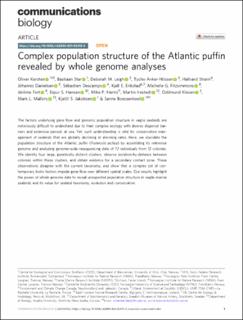| dc.contributor.author | Kersten, Oliver | |
| dc.contributor.author | Star, Bastiaan | |
| dc.contributor.author | Leigh, Deborah M. | |
| dc.contributor.author | Anker-Nilssen, Tycho | |
| dc.contributor.author | Strøm, Hallvard | |
| dc.contributor.author | Danielsen, Jóhannis | |
| dc.contributor.author | Descamps, Sebastien | |
| dc.contributor.author | Erikstad, Kjell E. | |
| dc.contributor.author | Fitzsimmons, Michelle G. | |
| dc.contributor.author | Fort, Jérôme | |
| dc.contributor.author | Hansen, Erpur S. | |
| dc.contributor.author | Harris, Mike P. | |
| dc.contributor.author | Irestedt, Martin | |
| dc.contributor.author | Kleven, Oddmund | |
| dc.contributor.author | Mallory, Mark L. | |
| dc.contributor.author | Jakobsen, Kjetill S. | |
| dc.contributor.author | Boessenkool, Sanne | |
| dc.date.accessioned | 2022-01-03T09:10:27Z | |
| dc.date.available | 2022-01-03T09:10:27Z | |
| dc.date.created | 2021-08-25T09:40:43Z | |
| dc.date.issued | 2021 | |
| dc.identifier.issn | 2399-3642 | |
| dc.identifier.uri | https://hdl.handle.net/11250/2835732 | |
| dc.description.abstract | The factors underlying gene flow and genomic population structure in vagile seabirds are notoriously difficult to understand due to their complex ecology with diverse dispersal barriers and extensive periods at sea. Yet, such understanding is vital for conservation management of seabirds that are globally declining at alarming rates. Here, we elucidate the population structure of the Atlantic puffin (Fratercula arctica) by assembling its reference genome and analyzing genome-wide resequencing data of 72 individuals from 12 colonies. We identify four large, genetically distinct clusters, observe isolation-by-distance between colonies within these clusters, and obtain evidence for a secondary contact zone. These observations disagree with the current taxonomy, and show that a complex set of contemporary biotic factors impede gene flow over different spatial scales. Our results highlight the power of whole genome data to reveal unexpected population structure in vagile marine seabirds and its value for seabird taxonomy, evolution and conservation. | en_US |
| dc.language.iso | eng | en_US |
| dc.publisher | Nature Research | en_US |
| dc.rights | Navngivelse 4.0 Internasjonal | * |
| dc.rights.uri | http://creativecommons.org/licenses/by/4.0/deed.no | * |
| dc.title | Complex population structure of the Atlantic puffin revealed by whole genome analyses | en_US |
| dc.type | Peer reviewed | en_US |
| dc.type | Journal article | en_US |
| dc.description.version | publishedVersion | en_US |
| dc.source.volume | 4 | en_US |
| dc.source.journal | Communications Biology | en_US |
| dc.identifier.doi | 10.1038/s42003-021-02415-4 | |
| dc.identifier.cristin | 1928562 | |
| dc.relation.project | Norges forskningsråd: 192141 | en_US |
| dc.relation.project | Notur/NorStore: NS9003K | en_US |
| dc.relation.project | Notur/NorStore: NS9244K | en_US |
| dc.description.localcode | Open Access This article is licensed under a Creative Commons Attribution 4.0 International License, which permits use, sharing, adaptation, distribution and reproduction in any medium or format, as long as you give appropriate credit to the original author(s) and the source, provide a link to the Creative Commons license, and indicate if changes were made. The images or other third party material in this article are included in the article’s Creative Commons license, unless indicated otherwise in a credit line to the material. If material is not included in the article’s Creative Commons license and your intended use is not permitted by statutory regulation or exceeds the permitted use, you will need to obtain permission directly from the copyright holder. To view a copy of this license, visit http://creativecommons.org/licenses/by/4.0/. | en_US |
| cristin.ispublished | true | |
| cristin.fulltext | original | |
| cristin.qualitycode | 1 | |

